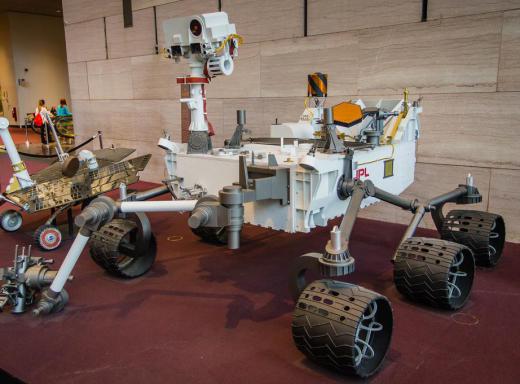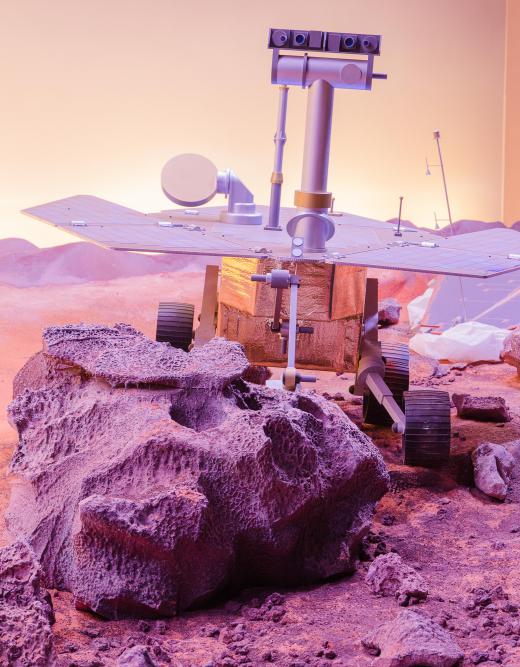What is the Mars Rover?
 Mary McMahon
Mary McMahon
There have in fact been several Mars rovers, rather than one specific spacecraft sent to Mars. These spacecraft are used to explore the surface of Mars for the purpose of gathering scientific data of interest to people on Earth. Thus far, only the United States has successfully launched and landed Mars rovers, with several missions to date.
A rover is designed to land on the surface and traverse it, gathering valuable information. Roving technology can be used to explore a variety of celestial bodies in addition to Mars, and robots have also been utilized to gather data about hostile environments such as the bottom of the ocean. A Mars rover has a rugged design which allows it to survive on the surface of Mars, along with an autonomous computer which directs the rover, and communication methods to send images and data back to Earth.

There are several reasons to send out a Mars rover. First of all, rovers provide much more information than orbiting spacecraft, allowing researchers to learn more about the climate of Mars and what the terrain is like. Unlike human astronauts, a Mars rover can survive just fine on the surface of Mars, and it can endure the trip to the fourth planet. The National Aeronautics and Space Administration (NASA) has stated that it is using rovers to learn more about the environment on Mars and the history of the planet, and to prepare for potential human exploration.

The earliest attempt at a Mars rover was made in 1971, when two attempts were made to send robots to Mars, and both failed. In 1997, the Sojourner was launched to explore Mars. Although it landed successfully, it failed within a few months, much to the frustration of scientists. Another launch in 2003 resulted in the 2004 landings of the Mars Spirit and Mars Opportunity, two rovers which were gathering data as of 2009.

These robots have sent back some astonishing images of the surface of Mars which have revealed a great deal of information about the terrain of the planet. They have also taken geological samples and provided a wide array of useful scientific data. NASA periodically releases information and images of interest from its Mars rover projects, to keep the public interested in the sciences and to promote the Mars rover program. Scientific research on Mars is quite expensive, and NASA relies heavily on the support of the public to receive continued government funding.
AS FEATURED ON:
AS FEATURED ON:














Discussion Comments
I still believe that visiting neighboring planets and exploring our solar system should be one of the main priorities of our species. With projects like the Mars rovers we are learning more than ever about how planets are evolving and changing, and what could rest in the future for our own world.
If scientists are right and Mars was once a planet rich with water, and even possibly with life, what happened to make it the barren wasteland we see today?
Is it possible that we could find rich resources on neighboring planets? Resources that would help us preserve our own world?
Right now, we don't know, but hopefully continuing projects such as the Mars rovers will make some more interesting findings.
@Alchemy - I found it interesting that the Mars rover ended up being abandoned because its batteries died. I know the Mars rovers function off solar panels and have rechargeable batteries that can degrade over time, but you think they would have worked in a way to change the batteries or carry more backups, considering how expensive the product is.
I wonder if in the future they will be able to make smaller robots that will be able to change batteries and conduct simple repairs on their rovers? That would be really something if they could create a network of robots looking after one another on a distant planet.
How was the mars rover landing possible? It seems like such delicate equipment would have been broken to pieces during touchdown. What an amazing feat of engineering!
This was a great article and it makes me crave more information on the mars project. It is refreshing to read something on the internet that makes me want to learn more about science, technology, and how things work.
@Alchemy- You stated something that makes the mars rovers just as important to the scientific community as the Hubble telescope. Your statement about the silica rich sand that Spirit is stuck in was discovered by accident when operators were trying to back the rover off a rock. Spirit uncovered the silica as it dragged its broken wheel across the ground while in reverse. The camera spotted the shimmering sand, and identified the substance as silica.
Finding silica was probably the most significant discovery by either of the rovers because it proves there was water or steam that could support microbial life. The discovery brings scientists one step closer to determining if there was ever life on mars, and would not have been possible if the rover did not break down.
@highlighter- Sadly, the mars rover Spirit is still stuck. NASA has officially ended its mission after six years of broadcasting images and performing experiments on mars. The rover has been stuck on a silica laden sand bed since March 22, 2010 without transmitting a signal. The batteries were extremely low before shutting down for the last mars winter, not leaving the rover with enough power to restart to charge during the Martian spring.
Although Spirit has been stuck for a significant portion of its mission, it has still outperformed all expectations. The two rover craft on mars originally had a three-month mission plan, but they have explored the Martian surface for almost 7 years. A year and a half after Spirit went offline; Opportunity is still transmitting video while trudging across the landscape. The Opportunity is currently making its way to the downed spirit rover, currently at the edge of the crater where spirit lay dormant.
Does anyone know if the Mars Rover is still stuck or if it has freed itself? Are they still sending back information from Mars? How much longer are they expected to last on the planet? I have not kept up on the progress of the rovers in the last year or so.
I have seen some of the pictures transmitted back from the planet, mostly on television shows. They are some of the coolest pictures ever. I personally think that the landing of the Mars rovers was as important for American space exploration as the moon landing, albeit not as dramatic. This is the first step in putting a base, and possibly a team on mars.
I actually go to the school that helped NASA develop the Mars Spirit and Opportunity rover vehicles. U.S. News and Reports recently named Arizona State University one of the best schools for geological sciences, and that particular department developed the Mini-TES robots aboard the rovers. A number of ASU researchers are also members of the Spirit and Opportunity teams.
The rovers have collected invaluable data on the red planet, and the geologic information collected by the Mini-TES robots has been some of the most important. These robots are capable of identifying minerals at a distance, and created the first mineral maps of the surface of mars. These maps show the concentration of different mineral concentrations, which are transmitted back to Earth. The Work on the Mars Rover project is a great source of pride at ASU, showing that the school is much more than just fun in the sun.
Post your comments